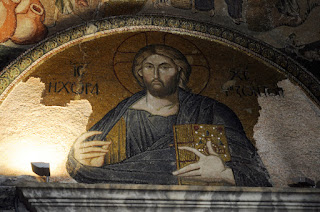When the daughter of the Ottoman Sultan Süleyman the Magnificent turned 17, two powerful men wanted to marry her. The name of Süleyman’s daughter was Mihrimah which meant in Persian “the sun and the moon”. One of the two men was a provincial governor while the other was the famous Architect Sinan (originally an Armenian but converted under a system called devshirmeh) whose greatest works include the Suleymaniye Mosque in Istanbul. At the time, despite being madly in love with her, Sinan was 50 and already married. So Mihrimah married the governor. Soon thereafter, Sinan was commissioned by the Palace, to build a Mihrimah mosque in Üsküdar (on the Asian side of Istanbul). When finished, the mosque looked like a woman with her hair reaching down below. After a while, still in love, Sinan started building this time on his own (without being commissioned) on the European side of Istanbul on a high hill a small mosque, also named Mihrimah.
 |
| Pray time for believers in Mihrimah mosque in Istanbul. |
 |
| Play time for kids at the Mihrimah mosque in Istanbul. |
When finished, this mosque equally looked like a woman whose hair reached her ankles. There was another particularity: on 21 March, the birthday of Mihrimah (happens to be also when the day and night are equal), one can see that when the sun is setting behind the minarette of the Mihrimah mosque on the European side, the moon is coming out behind the Mihrimah mosque on the Asian side. The sun and the moon: Mihrimah… what a love, what a man devoting his art and mastery of skill to his unacquainted love…. (Special thanks for the story).
 |
| Sketches of the Mihrimah Mosque in Istanbul. |
 |
Renovators are still at work in Mihrimah mosque (in Edirnekapı), on European side of Istanbul. |
 |
| Mihrimah mosque from outside, in an unassuming part of Istanbul called Edirnekapı. |
Jesus Pantokrator fresco of 14th century at St. Choir Church (museum) in Istanbul. Photo: Zeren Göktan. |
 |
| The fresco of the death of Virgin Mary at St. Choir in Istanbul. Photo: Zeren Göktan. |
 |
| Giftshop of St. Choir featuring pretty travel journals. Photo: Zeren Göktan. |
 |
| The stuffed quince of 1539 at Asitane restaurant in Istanbul. Photo: Zeren Göktan. |
Then head to Istanbul Modern for more art: but this time for modern Turkish painting. The location of the museum is right by the entrance of the Golden Horn. So you should plan to have your sunset drink at the Café of Istanbul Modern. Especially the terrace of the café has a view all the way from the Bosphorus Bridge to Blue Mosque and beyond. The busy ferries, the sea and seagulls make a typical Istanbul picture that cries out to be taken by the tourist who follows TravelmindJ. Also note that the museum store has wonderful gifts for those back home.
 |
| A view of the Bosphorus at the terrace of Istanbul Modern's café. |
 |
| Old Peninsula: from left to right Topkapı Palace, St. Sophia and the Blue Mosque from the terrace of Istanbul Modern. |
 |
| Inside Istanbul Modern's café, you can also have the same view by looking at the mirrors. |
Lastly, if you happen to be in Istanbul until mid January 2011, at Istanbul Modern you should visit the exhibition about Armenian Architects of Istanbul. While Turkey tries to come to grips with its past, it is pretty amazing to realize that beyond the rhetoric, we owe the silhouette and many landmark buildings of Istanbul to Armenian architects. One family, the Balyans, seem to have especially contributed the most by building the Dolmabahce Palace; Kuleli Military School (where Muammer Kaddafi was a student); Selimiye military barracks (world’s largest historical military barracks); Çırağan Palace, Ortaköy Mosque (my favorite); Beylerbeyi Palace; Akaretler and today’s Istanbul University’s Presidency. The latter used to be the Ministry of War in the last years of the Ottoman Empire when the government was basically ruled by three Pashas of the Ottoman Army. Sadly, in 1915, in this building they decided to exile the whole Armenian population of Turkey to Syria which basically led to the massacre and ultimate death of millions of people and a culture to vanish.
 |
| A photo from the Armenian architects exhibition showing the Presidency building of Istanbul University. |
Yes, my Istanbul is a bizarre place that gives you amazement, pride, hope and sadness, all in one day. This is why I love it.
A shorter version of this post is available at hurriyet daily news.
A shorter version of this post is available at hurriyet daily news.


